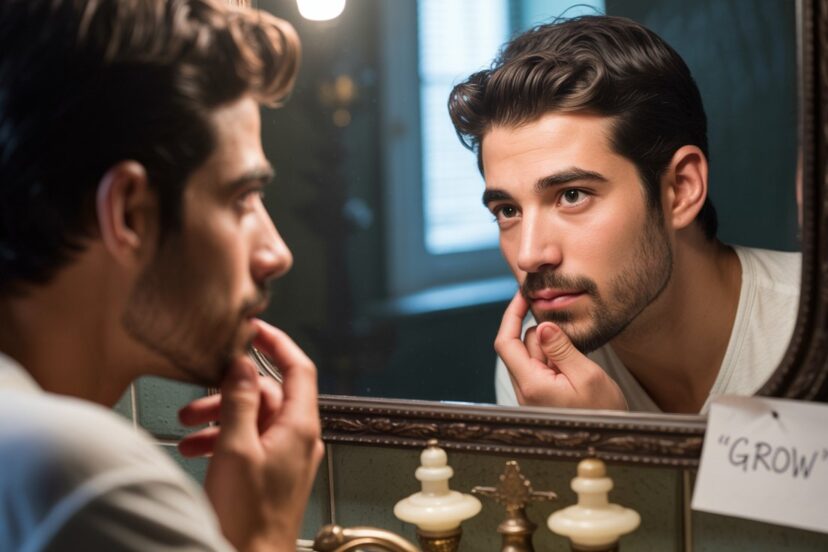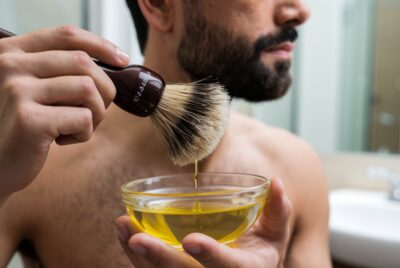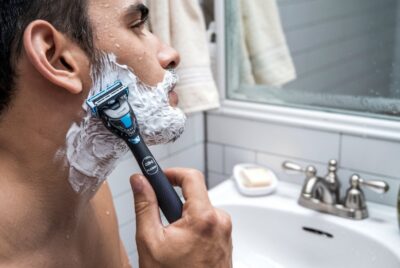Facial Hair Growth: Understanding the Science Behind Your Beard
Post Disclaimer
*We may earn a commission for purchases made using our links. Please see our disclosure to learn more.
The mirror doesn’t lie. Every morning, countless men examine their reflection, wondering why their facial hair grows the way it does. Some wake up to a shadow that seems to appear overnight, while others struggle for months to achieve even the faintest stubble. The journey of understanding facial hair growth is more complex than most realize, involving intricate biological processes that have fascinated scientists and frustrated men for generations.
Whether you’re a teenager eagerly waiting for your first whiskers or an adult seeking to optimize your beard growth, understanding the science behind facial hair development can transform your approach to grooming and set realistic expectations for your hair growth journey.
Key Takeaways
- Facial hair growth occurs in three distinct phases: anagen (growth), catagen (transition), and telogen (rest)
- Genetics and hormones, particularly testosterone and DHT, are the primary drivers of facial hair development
- The average facial hair grows 0.5 inches per month, but individual rates vary significantly
- Age, nutrition, stress levels, and overall health significantly impact hair growth patterns
- Understanding your natural growth cycle helps set realistic expectations and optimize grooming routines
“The complexity of hair growth lies not just in its biological mechanisms, but in how multiple factors—from genetics to lifestyle—interact to create each person’s unique growth pattern.”
– Journal of Dermatological Science
The Three Phases of Facial Hair Growth
Anagen Phase: The Growth Engine
The anagen phase represents the active growth period where hair follicles work tirelessly to produce new hair strands. During this crucial stage, cells in the hair root divide rapidly, pushing the hair shaft upward through the skin. For facial hair, this phase typically lasts between two to six years, though individual variation is substantial.
What makes this phase remarkable is its consistency. Hair grows approximately 0.5 inches per month during anagen, regardless of whether you shave, trim, or leave it untouched. The common myth that shaving accelerates growth stems from the blunt cut creating an illusion of thickness, but the underlying growth rate remains constant.
The duration of your anagen phase directly determines your maximum beard length potential. Men with longer anagen phases can grow impressively long beards, while those with shorter cycles may find their facial hair reaches a plateau regardless of patience or effort.
Catagen Phase: The Transition Period
Following the growth phase comes catagen, a brief but essential transition lasting only two to three weeks. During this period, hair follicles begin to shrink and detach from the blood supply that nourished them during active growth. The hair shaft stops growing but remains anchored in the follicle.
This transitional phase serves as a reset mechanism, preparing the follicle for the upcoming rest period. While catagen represents only a small fraction of the hair’s lifecycle, it plays a crucial role in maintaining healthy hair regeneration patterns.
Understanding catagen helps explain why some areas of facial hair may appear patchy or uneven. Different follicles enter this phase at various times, creating the natural variation in hair length and density that characterizes most beards.
Telogen Phase: Rest and Renewal
The telogen phase marks a period of dormancy lasting three to four months. During this time, the old hair remains in place while the follicle rests beneath the surface. Eventually, new growth begins, pushing out the old hair and restarting the cycle.
This resting phase explains the natural shedding that occurs even in healthy beards. Men often worry when they notice hairs falling out during washing or brushing, but this shedding represents normal follicle renewal rather than permanent loss.
The length of telogen varies among individuals and can be influenced by stress, illness, or hormonal changes. Extended rest periods may result in temporarily thinner facial hair until normal cycling resumes.
Hormonal Influences on Facial Hair Development
Testosterone: The Foundation Hormone
Testosterone serves as the primary driver of male secondary sexual characteristics, including facial hair development. Produced mainly in the testicles, this hormone signals hair follicles to begin producing terminal hairs—the thick, pigmented strands that form visible facial hair.
The relationship between testosterone and facial hair isn’t simply about total hormone levels. Sensitivity to testosterone varies significantly among individuals due to genetic factors affecting androgen receptors. Some men with moderate testosterone levels develop thick, full beards, while others with higher levels may struggle with patchy growth.
Testosterone levels naturally fluctuate throughout the day and across seasons, potentially influencing growth patterns. Peak levels typically occur in the morning, which may explain why some men notice more pronounced growth after periods of rest.
DHT: The Powerful Activator
Dihydrotestosterone (DHT) represents a more potent form of testosterone, created when the enzyme 5-alpha reductase converts testosterone in hair follicles and other tissues. DHT demonstrates five times greater potency than testosterone in stimulating facial hair growth.
The concentration of 5-alpha reductase in facial hair follicles helps explain why men can develop impressive beards even when scalp hair begins thinning. The same hormone that promotes facial hair growth can simultaneously contribute to male pattern baldness, creating an ironic trade-off for many men.
Individual variation in DHT sensitivity explains much of the diversity in facial hair patterns. Men with highly sensitive follicles may develop dense, fast-growing beards, while those with lower sensitivity may experience slower, patchier development.
Genetic Factors: Your Inherited Blueprint
Family Patterns and Predictions
Genetics provide the fundamental blueprint for facial hair development, influencing everything from growth rate to pattern distribution. Observing male relatives often provides valuable insights into potential beard development, though individual variation remains significant.
The inheritance of facial hair traits follows complex patterns involving multiple genes. While dominant traits from fathers often appear prominently, maternal genetics also contribute significantly to hair characteristics. This multi-generational influence explains why some men develop facial hair patterns that don’t directly mirror their fathers.
Ethnic background plays a substantial role in facial hair characteristics. Mediterranean and Middle Eastern populations typically exhibit robust facial hair growth, while East Asian populations often experience more limited development. These patterns reflect thousands of years of genetic adaptation to different environments and cultural preferences.
Age-Related Development Patterns
Facial hair development follows predictable age-related progressions, though individual timelines vary considerably. Most boys begin developing facial hair during puberty, typically between ages 12 and 16, starting with fine, light-colored vellus hairs that gradually transform into darker terminal hairs.
The late teens and early twenties represent peak development periods when hormone levels stabilize and follicles mature. Many men notice their fullest, most consistent growth during this time, though some continue developing additional density into their thirties.
Interestingly, facial hair characteristics can continue evolving throughout life. Some men experience increased thickness and coverage in middle age, while others may notice changes in color, texture, or growth patterns as hormone levels naturally decline.
Environmental and Lifestyle Factors
Nutrition’s Role in Hair Health
Proper nutrition provides the building blocks necessary for healthy hair growth. Protein serves as the primary structural component of hair, making adequate intake essential for optimal development. Hair follicles rank among the most metabolically active tissues in the body, requiring consistent nutrient supply to maintain growth.
Key vitamins and minerals support various aspects of hair development. Biotin aids in keratin production, while zinc supports hormone metabolism and cellular repair. Iron deficiency can significantly impact growth rates, explaining why some men notice changes in facial hair during periods of poor nutrition or restrictive dieting.
Hydration affects hair quality and follicle health. Well-hydrated skin provides optimal conditions for hair emergence and reduces irritation that might impede growth. The relationship between internal hydration and external hair health demonstrates the holistic nature of hair development.
Stress and Its Growth Impact
Chronic stress significantly impacts hair growth through multiple mechanisms. Elevated cortisol levels can disrupt normal hormone balance, potentially reducing testosterone production and altering growth cycles. Stress also affects sleep quality, which plays a crucial role in hormone regulation and cellular repair.
The relationship between stress and hair growth creates concerning cycles for some men. Worry about slow or patchy growth can increase stress levels, potentially exacerbating the very problem causing concern. Understanding this connection helps men approach beard development with realistic expectations and reduced anxiety.
Managing stress through exercise, meditation, or other healthy outlets can support optimal growth conditions. While stress management won’t dramatically accelerate growth rates, it helps ensure follicles function at their genetic potential.
Sleep and Recovery
Quality sleep supports optimal hormone production and cellular repair processes essential for hair growth. Growth hormone, released primarily during deep sleep phases, plays important roles in tissue regeneration and protein synthesis.
Sleep deprivation can disrupt normal hormone cycles, potentially reducing testosterone production and affecting growth rates. Consistent sleep schedules help maintain stable hormone levels that support steady hair development.
The relationship between sleep quality and hair health extends beyond hormone production. Poor sleep often correlates with increased stress, reduced immune function, and poor nutrition choices—all factors that can negatively impact facial hair development.
Common Challenges in Facial Hair Development
Patchy Growth Patterns
Uneven or patchy facial hair represents one of the most common concerns among men attempting to grow beards. This pattern typically results from genetic variation in follicle density and hormone sensitivity across different facial areas.
The lower jawline and mustache area usually develop first and most densely, while cheek and neck areas may lag significantly. Understanding these natural patterns helps set realistic expectations and develop grooming strategies that work with, rather than against, individual growth characteristics.
Patience often proves the most effective remedy for patchy growth. Many men abandon beard-growing efforts during awkward intermediate stages, not realizing that continued growth and strategic trimming can create impressive results from initially unpromising beginnings.
Slow Growth Frustrations
Men accustomed to quick results in other areas of life often struggle with the patience required for facial hair development. The average growth rate of 0.5 inches per month means visible beards require several months of consistent growth, testing the persistence of many aspiring beard-growers.
Comparing growth rates with friends or online examples can create unrealistic expectations and frustration. Individual variation in growth speed is normal and largely determined by genetics rather than external factors under personal control.
Focusing on hair health rather than speed often yields better long-term results. Proper nutrition, stress management, and consistent grooming create optimal conditions for individual growth potential, even if that potential differs from others.
Texture and Color Variations
Facial hair texture and color often differ significantly from scalp hair, causing surprise for some men. These differences reflect distinct follicle characteristics and can include variations in curl patterns, thickness, and pigmentation.
Gray or white facial hairs may appear earlier than scalp graying, particularly in mustache areas. This premature graying reflects the unique aging patterns of facial follicles and doesn’t indicate overall health problems.
Embracing natural texture and color variations often creates more attractive results than attempting to force uniformity. Working with natural characteristics through appropriate styling and grooming techniques typically yields superior outcomes.
Optimizing Your Growth Environment
Skincare for Healthy Follicles
Healthy skin provides the foundation for optimal hair growth. Regular cleansing removes debris and excess oils that might clog follicles, while moisturizing maintains skin flexibility and reduces irritation.
Gentle exfoliation can help prevent ingrown hairs and promote healthy follicle function. However, over-aggressive scrubbing can damage delicate follicles and create inflammation that impedes growth.
The choice between specific beard care products and general skincare depends on individual needs and preferences. While specialized products may offer targeted benefits, consistent use of gentle, high-quality products often matters more than specific formulations.
Exercise and Circulation
Regular exercise supports hair growth through multiple mechanisms. Physical activity increases blood circulation, delivering nutrients and oxygen to hair follicles while removing waste products that might impede growth.
Exercise also helps regulate hormone levels and reduce stress—both factors that significantly impact hair development. The relationship between physical fitness and facial hair health demonstrates the interconnected nature of overall wellness.
Specific exercises targeting facial circulation, such as facial massage or targeted stretching, may provide additional benefits. While evidence for dramatic effects remains limited, these practices support general skin health and follicle function.
The Broader Impact of Understanding Growth
Setting Realistic Expectations
Understanding the science behind facial hair growth helps men set achievable goals and avoid common frustrations. Recognizing that genetics largely determine growth potential allows focus on optimizing health factors within personal control.
Realistic expectations reduce stress and anxiety that can negatively impact growth. Men who understand normal development timelines are more likely to persist through challenging growth phases and achieve satisfying results.
Education about growth phases and individual variation helps men make informed decisions about grooming timing and beard styling. This knowledge prevents premature trimming that might interrupt promising growth patterns.
Building Confidence Through Knowledge
Knowledge about hair growth science can boost confidence in personal grooming decisions. Understanding why certain approaches work or don’t work helps men develop personalized routines that support their individual goals.
The confidence that comes from scientific understanding often translates into patience and persistence—qualities essential for successful beard development. Men who understand the process are more likely to maintain consistent care routines that support optimal growth.
This understanding also helps men communicate more effectively with barbers and other grooming professionals, leading to better results and more satisfying grooming experiences.
Embracing Your Unique Growth Journey
Celebrating Individual Characteristics
Every man’s facial hair journey is unique, shaped by genetics, lifestyle, and personal choices. Rather than pursuing unrealistic ideals based on others’ growth patterns, embracing individual characteristics often leads to more satisfying results.
The diversity in facial hair patterns reflects human genetic diversity and should be celebrated rather than standardized. Men who work with their natural growth patterns typically achieve more attractive and maintainable results than those fighting against genetic predispositions.
Understanding that “perfect” beards exist only in heavily curated social media posts helps maintain realistic perspectives on personal growth achievements. Real facial hair includes natural variations, color differences, and growth patterns that reflect individual biology.
Long-term Perspective on Growth
Facial hair development represents a long-term journey rather than a quick transformation. Men who approach growth with patience and consistency typically achieve more satisfying results than those seeking rapid changes.
The relationship between time and hair development extends beyond simple length accumulation. Follicle maturation, color development, and texture refinement all continue over months and years, creating evolving characteristics that require adaptive grooming approaches.
Viewing facial hair growth as an ongoing process rather than a destination helps maintain motivation through challenging phases and celebrates incremental improvements that might otherwise go unnoticed.
Conclusion
The science of facial hair growth reveals a complex interplay of genetics, hormones, and lifestyle factors that shape each man’s unique grooming journey. Understanding these biological processes helps set realistic expectations while identifying opportunities for optimization within individual genetic constraints.
From the three distinct growth phases to the hormonal influences that drive development, facial hair growth represents a fascinating example of human biology in action. The knowledge gained from scientific research provides practical insights for men seeking to optimize their growth potential while avoiding common frustrations and unrealistic expectations.
Remember that facial hair growth is ultimately a personal journey shaped by individual biology and preferences. While science provides valuable insights into the mechanisms involved, the most important factor remains patience, consistency, and acceptance of your unique characteristics. Whether you’re seeking a full beard or simply trying to understand your growth patterns, embracing the science behind the process can lead to more satisfying and realistic grooming experiences.
The path to understanding facial hair growth extends beyond simple biological processes to encompass broader themes of self-acceptance, patience, and working with rather than against natural characteristics. By combining scientific knowledge with realistic expectations and consistent care, men can optimize their facial hair potential while appreciating the unique journey that defines their individual grooming experience.
Frequently Asked Questions
Q: How fast does facial hair actually grow?
A: Facial hair grows at an average rate of approximately 0.5 inches (1.25 cm) per month. However, this rate can vary significantly between individuals due to genetic factors, age, hormone levels, and overall health. Some men may experience slightly faster or slower growth rates within the normal range of 0.3 to 0.7 inches per month.
Q: Why does my facial hair grow unevenly or in patches?
A: Patchy or uneven facial hair growth is completely normal and primarily results from genetic variation in hair follicle density and hormone sensitivity across different areas of your face. The mustache and jawline typically develop first and most densely, while cheek areas may take longer to fill in. Many men find that continued growth and patience help minimize the appearance of patches over time.
Q: Can I do anything to speed up my facial hair growth?
A: While you cannot dramatically alter your genetically determined growth rate, you can optimize conditions for healthy hair development. Maintaining good nutrition (especially adequate protein, biotin, and zinc), managing stress levels, getting quality sleep, exercising regularly, and keeping your skin clean and moisturized all support optimal growth within your genetic potential.
Q: At what age does facial hair stop developing?
A: Facial hair development varies significantly among individuals. Most men begin developing facial hair during puberty (ages 12-16), with peak development typically occurring in the late teens and early twenties. However, many men continue to see increases in density and coverage into their thirties. Some characteristics like color and texture may continue evolving throughout life as hormone levels naturally change.
Q: Does shaving really make facial hair grow back thicker or faster?
A: No, shaving does not actually make hair grow faster or thicker. This persistent myth likely stems from the fact that shaving creates a blunt cut that can make hair appear thicker when it first emerges. The underlying growth rate and hair thickness are determined by genetics and hormones, not by cutting the hair shaft. Regular shaving simply maintains the appearance of the hair but doesn’t alter its fundamental characteristics.




